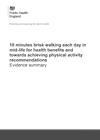International evidence and the UK Chief Medical Officers’ (CMOs) guidelines highlight the frequency and type of physical activity required to achieve general health benefits, particularly the benefit of 150 minutes physical activity of at least moderate intensity each week.
The 150 minutes or more per week recommendation in guidance provides the level at which health benefits are achieved across a wide range of conditions for an achievable amount of time over a week. However a reduced level of benefits may be achieved through activity at less than the optimum 150 minutes, with some benefits shown even at levels of 10 minutes or more of at least moderate intensity activity.
‘Brisk’ walking (at least 3 mph) is a moderate intensity physical activity and evidence-based intervention for promoting physical activity. It is already prevalent, has no skill, facility or equipment requirement and is more accessible and acceptable than other forms of physical activity. This report, based on a rapid review of the evidence, summarises the potential benefits of 10 minute blocks of brisk walking as part of a contribution to the CMO recommended levels of activity.
For currently inactive individuals, evidence shows the following health benefits could be achieved from 10 minutes of brisk walking per day for 7 days:
- increased physical fitness
- greater ease of performance of everyday physical activities
- improved mood
- improved quality of life
- increased body leanness and healthier weight
- 15% reduction in risk of early death
Individuals with an existing health condition would likely achieve greater health benefits due to improvements in management of their condition and reduced risk of developing comorbidities. However further work is needed to explore the equivalent opportunity for some people living with disabilities, especially those with lower limb mobility impairments, which inhibit walking.
An additional 10 minutes brisk walking per day is likely to be seen as achievable by the one in four adults in England who are currently classified as ‘inactive’ by virtue of doing less than 30 minutes physical activity per week. In addition walking interventions in people active but not achieving CMO’s guidelines (low activity) have consistently achieved an additional 30 minutes of walking per week, lifting people out of the ‘inactive’ category at which the greatest risks to health persist.
The accessibility and acceptability of walking has particular potential for a cohort of the population with particular need for increased physical activity and who are currently inactive or doing less than the UK CMO’s guidelines, particularly those in mid-life (aged 40-60 years) in lower socioeconomic groups22. If one in 10 of the seven million people within this cohort of the English population started to do 10 minutes of walking per day, it is estimated it would prevent 251 deaths per year and achieve an economic saving of £310 million per year.
Public Health England exists to protect and improve the nation’s health and wellbeing, and reduce health inequalities. We do this through world-class science, knowledge and intelligence, advocacy, partnerships and the delivery of specialist public health services. We are an executive agency of the Department of Health, and are a distinct delivery organisation with operational autonomy to advice and support government, local authorities and the NHS in a professionally independent manner.



Responses